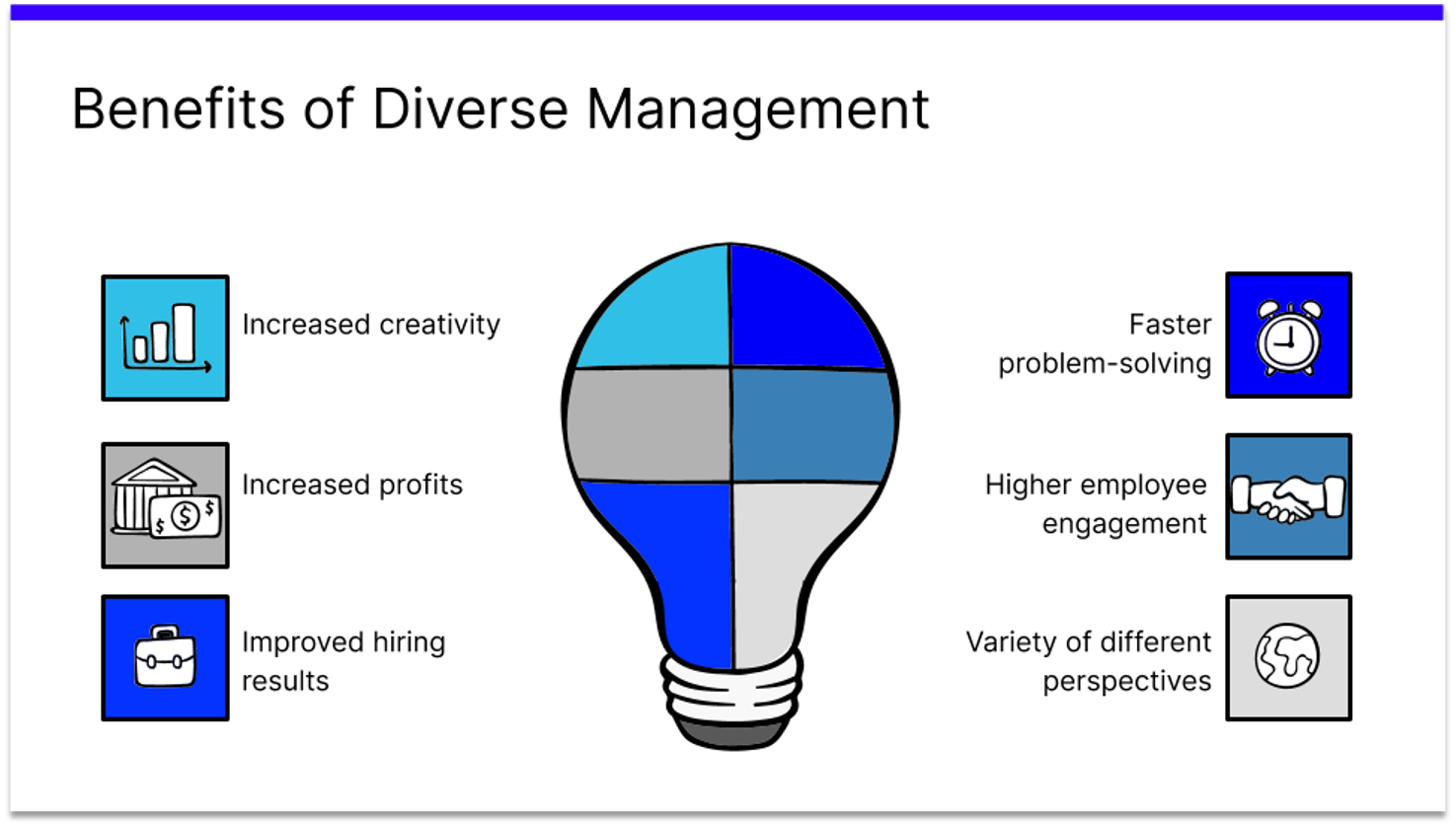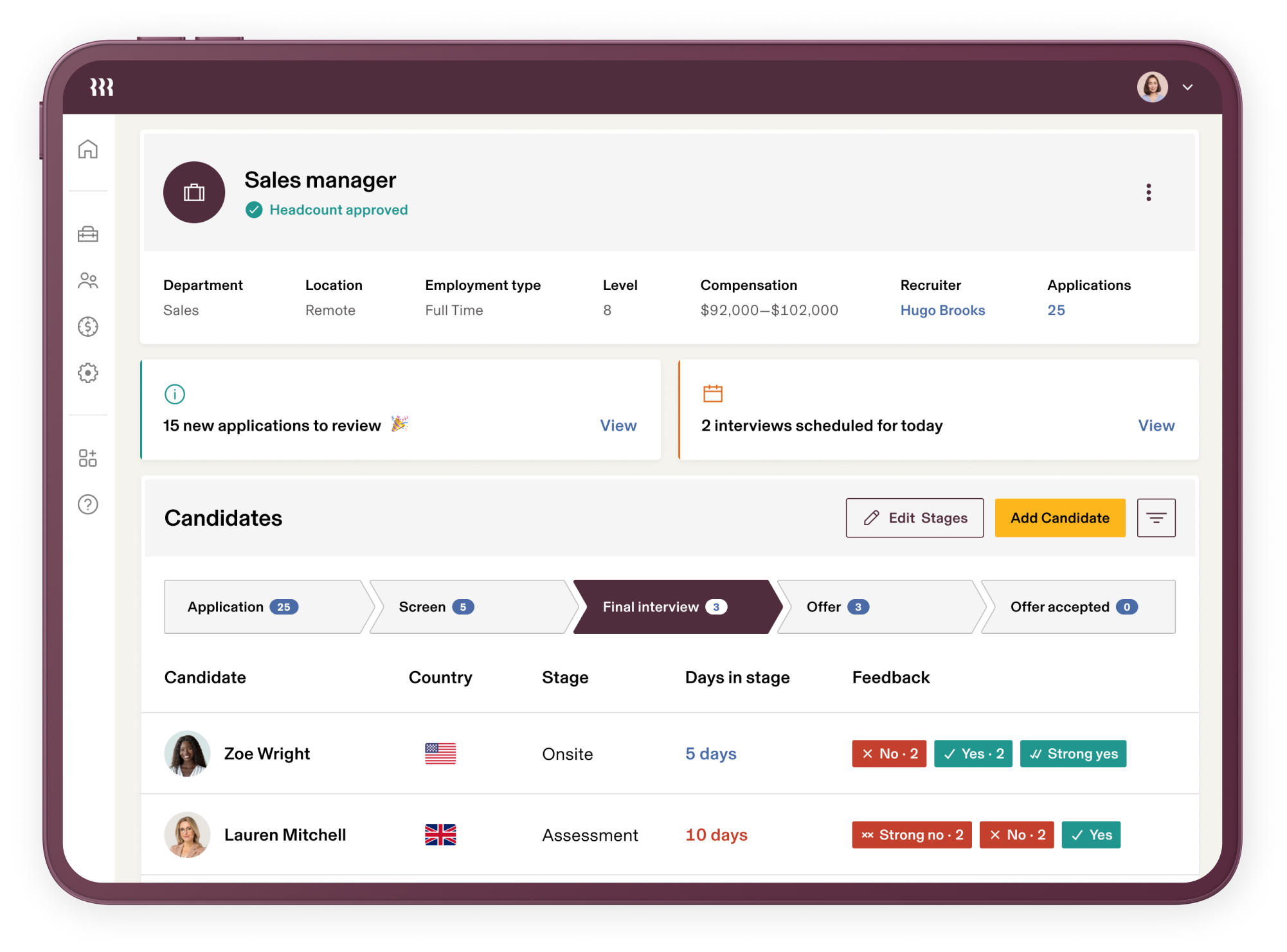The initial experiences of joining a company are key to ensuring that an employee will understand their role and the company culture. In fact, a good onboarding process will determine whether an employee will stay with a company or not. Research shows that 69% of employees are more likely to stay with a company for over three years if they experienced great onboarding.
It is clear that the quality of an onboarding process is conducive to the success of any new hire. Consequently, it is important that employees feel supported and welcome from their first day. Effective onboarding requires planning and commitment from all involved. Proactive hiring managers that can coordinate a consistent onboarding program company-wide will facilitate much better employee engagement after the initial 90 days.
In this article, we set out the top 10 steps to establish a successful onboarding process. At PeopleGoal, we offer a range of onboarding apps that will referenced throughout these 10 steps. HR professionals or hiring managers alike can learn a thing or two from the following suggestions. If your onboarding process aligns with the steps outlined below then you will be on track to producing high levels of employee engagement as a result of a positive onboarding experience.
Onboarding 101
What is Onboarding?
The onboarding process can be defined as ‘The process of moving a new hire from applicant to employee status ensuring that paperwork is done, benefits administration is underway, and orientation is completed’.
This skeleton definition of onboarding summarizes the fundamentals of the onboarding process but it does not shed as much light on the real practice. A properly executed onboarding program will require far more hands-on activity, it is not simply a case of arranging the employee’s paperwork.
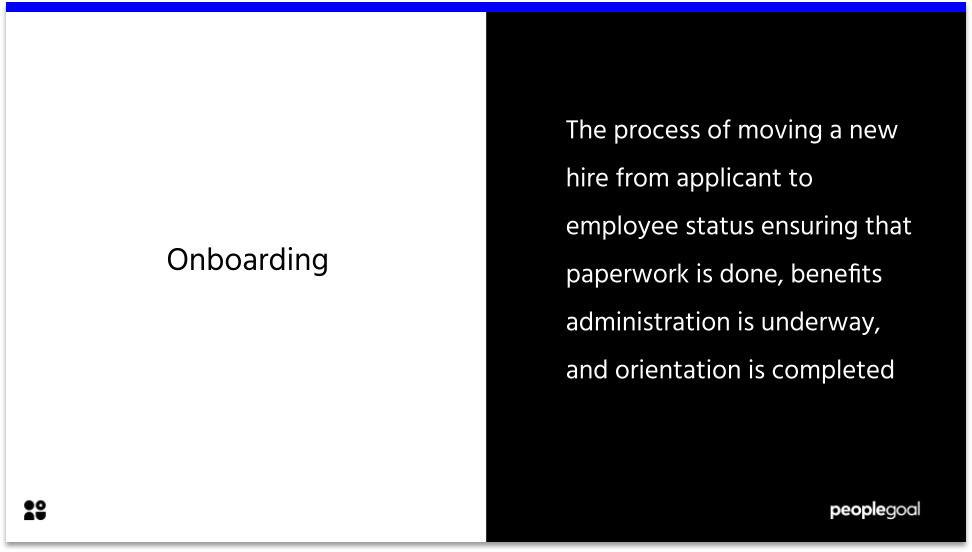
Onboarding Checklist
In order to assist a more successful onboarding process, it is advised to establish a clear onboarding plan. The use of an onboarding checklist will facilitate both new hires and the hiring managers as they can track a very clear route for the employee’s first moments with the company.
Provided that the HR team has produced an onboarding checklist that covers all of the needs for the new employee, the process of onboarding should run smoothly. An onboarding process including guidance on using the office space, getting to know the team and their expectations of the role will stand the employee in good stead.
Download the 90 Day Onboarding Checklist Template in Google Sheets and Excel here.
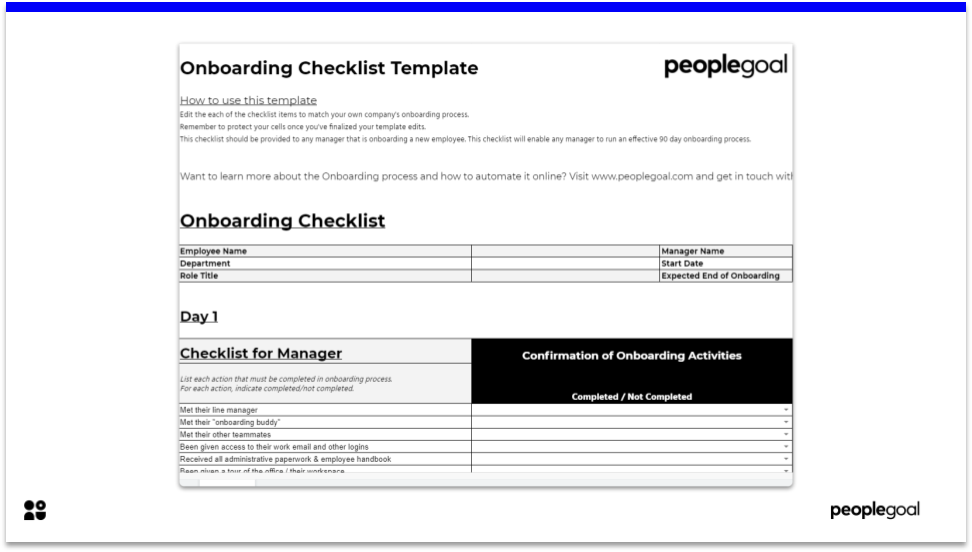
Benefits of Great Onboarding
As this article has already demonstrated, there are some clear benefits to establishing a great onboarding program. Here we outline what these benefits are:
- Reduced time to productivity
- Greater employee engagement
- Greater job satisfaction
- Higher performance, loyalty and lower stress
- Higher employee retention rates
- Clarity over company’s mission and values
- Quicker upskilling of new hires
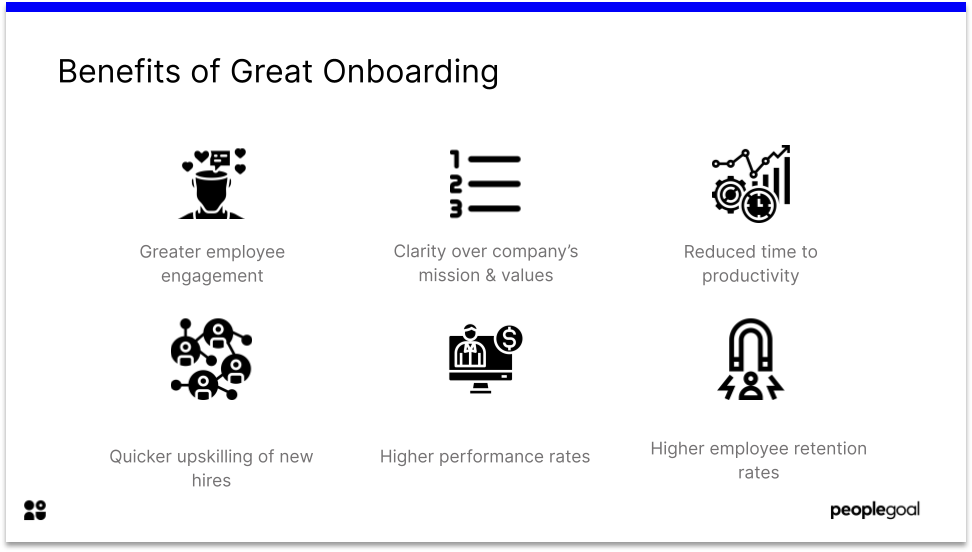
Onboarding and Employee Engagement
There is an strong link between the onboarding process and employee engagement. Done correctly, the onboarding process is highly effective at ensuring a good level of employee engagement.
As presented by Harvard Business Review, in the initial 90 days, the employee will be presented with an assortment of information about the company culture and practices. This process of familiarizing the employee with the company’s mission will enable the individual to better understand how they align with the organization.
Research shows that employees who experienced effective onboarding were 18 times more likely to feel highly committed to their organization. Evidently, the power of a good onboarding process is shown in its capacity to coerce employees to commit to the organization.
An employee’s experience of work hinges on the proficiency of their onboarding process. Ensuring that an employee feels welcomed as a member of the team will significantly improve retention rates.
High retention rates are especially important when considering the expense of replacing an employee. On average it can cost from 50% to 200% of the ex-employee’s annual salary to find and onboard a new employee. Clearly, an effective onboarding process is more productive and cost-efficient.

Why is the Onboarding Process important?
If you’ve ever had a bad experience joining a new company, you’ll likely have known this from day one. A disorganized process leads to confusion, uncertainty and a general bad taste for a new hire. So what are the benefits of getting onboarding right, and why does it matter?
- New hires gain a sense of belonging and purpose within the organization, leading to greater commitment and engagement.
- Knowing exactly what’s expected of them means employees perform better, have lower stress levels and can focus on delivering their initial objectives.
- Both of the above leads to greater job satisfaction, which in turn leads to higher employee retention and reduced turnover rates. This makes a huge impact on talent planning in particular, as the costs of replacing a role are significant.
New hires can take up to five months to settle in and achieve their full productivity, and that’s a long time to invest in someone who may not be sticking around past their probation. The quicker and more widely you can integrate an employee into the company culture and ways of working, the easier they’ll find their feet and get down to contributing to the team success. Creating a clear onboarding process template will help you to plan effectively and keep on top of regular check-ins with your new employees.

Top 10 Steps for a Successful Onboarding Process
- Map out the process/ Onboarding Process Template
- Create an orientation program
- Assign a peer mentor/ Offer Support
- Proactive Manager
- Routine Check-Ins
- Onboarding feedback Opportunities
- Easing Remote Onboarding
- Distribute the Employee Handbook
- Promote Personal Development
- Onboard in cohorts (if applicable)
1. Map out the Onboarding Process
Devote some time to go through the agenda of the week with the new hire. See if they are clear on it and whether they have any questions. A tricky part about onboarding is that it all seems straightforward and easy to you now, but try to remember what it was like when you joined the company. The little things that you consider so natural now are what makes the difference to the experience of the employee.
Ensure that new employees have a clear understanding of the daily, weekly and monthly processes of the company. An ability to better visualize what the experience of work will entail facilitates the employee onboarding to attain a greater awareness of what is expected of them in their role.
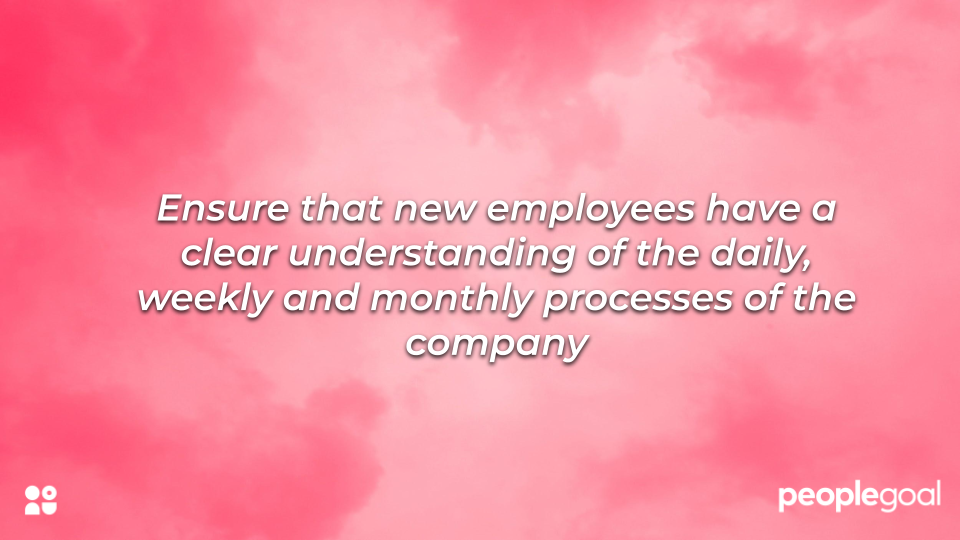
From outlining dates for training sessions to times for team video calls, new employees significantly benefit from having a well-planned onboarding program. HR professionals that can provide an effective onboarding checklist will make the first 90 days far more enjoyable.
Take a look at another of our articles which guides you through the process of setting up your own onboarding process: Employee Onboarding Process Template.
2. Create an Orientation Program
When starting in a new job, many employees will want to learn about the specifics of their role and the expectations they must fulfill. Be sure to send over documents covering areas such as the onboarding process, the company’s work policy and any other information that will be important and useful for them to know.
Employee orientation is vital to providing the employee with a genuine opportunity to succeed with the company.
A new employee will also likely want to know about the company culture and history, therefore create some form of document or presentation that they can read. This will give the remote employee onboarding a more rounded appreciation of the company. Employee orientation is vital to ensure the new hire feels aligned with the company’s goals. It also compensates for what they might not be able to easily interpret regarding the work environment when working remotely.
A precise and informative employee orientation is vital to presenting an employee with the necessary guidance to approach their new role. Without preparing the new hire for their role, it is highly likely that they will become disengaged. Promoting company culture and outlining the specifics of their role is crucial to encouraging the employee to better engage with their work.
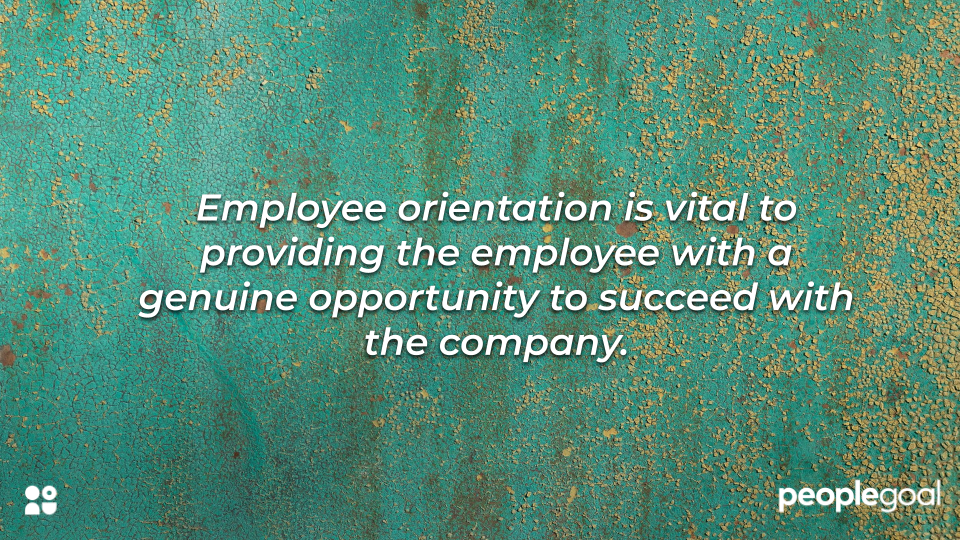
3. Assign a peer mentor
Appointing a colleague to be the new hire’s friendly face and go-to guide is an easy way to make a new hire feel welcome, and give them a relaxed space to ask questions and figure out the company culture at their own pace. We recommend that you consider assigning a peer mentor to new hires, as they can help to support them as they settle in.
Peer mentors are sometimes managers, but it can work better to assign an employee at the same level. This is a great way to create a social, supportive environment.
Shelby Kier recommends carefully matching peer mentors to mentees, and ensuring mentors are not overscheduled. Some new hires work best through one-on-one communication. This makes onboarding more personalized.
4. Proactive Manager
Looking at the most effective approach to the employee onboarding process, the optimal onboarding strategy must entail a comprehensive breakdown of the employee’s role within the organization. On top of this, a manager must be assigned to oversee and confirm that the employee has truly completed the various tasks for their onboarding. This ‘onboarding manager‘ will be responsible for going through the employee’s onboarding checklist and running routine check-ins to track their progress.
It is important for a manager to be proactively engaged in an employee’s onboarding. This is not only beneficial for the employee to have a reliable source of information, but it also distributes the responsibility of completing the onboarding process across the employee and the manager. With a consistent and reliable channel for communication, the employee can iron out any issues or difficulties that they are experiencing during the initial phases of being with the company.
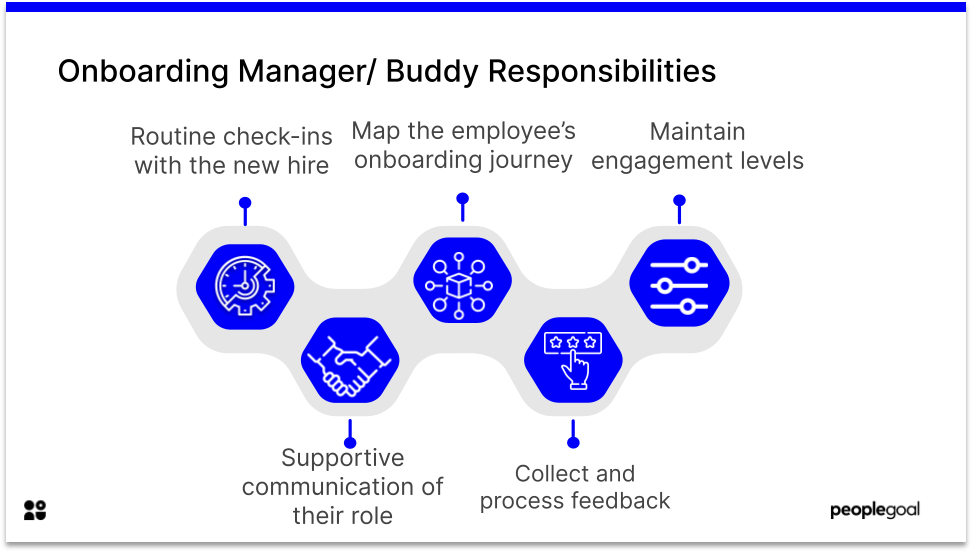
Leaving employees with the duty of defining and establishing their own roles and responsibilities is seen to take up less time than running an onboarding process but this simply isn’t the case.
An employee that lacks support when first joining a company is far more likely to become disengaged. This often stems from being overwhelmed by the uncertainty of their position within the organization.
Low levels of employee engagement lead to higher turnover rates and so effectively, the onboarding process is set back to square one.
In contrast, when an organization invests some time into tying a manager to the employee onboarding process they are far more likely to become engaged with their work as they have had opportunities to learn about the company culture and their team members.
5. Routine Check-Ins
Onboarding doesn’t all happen on day one or even week one. Create a multi-week onboarding program with plenty of check-ins to get new hires fully immersed in the business, their colleagues and their objectives.
In order to give the employee as much assistance as possible, the hiring manager should schedule a regular time to have a check-in with the new hire. On the first day, at the end of the first week and each month for the first 3 months will be extremely constructive for the employee. These meetings will provide the employee with the opportunity to air any of their concerns. Moreover, these meetings will be beneficial for the manager to set out throughout the onboarding process.
Through the check-ins, the hiring manager will be able to determine how happy the employee is to be working for the company. Tracking employee engagement and satisfaction will provide great insights for HR teams to understand and improve the onboarding experience. Without employee feedback, it is impossible for the onboarding process to improve.
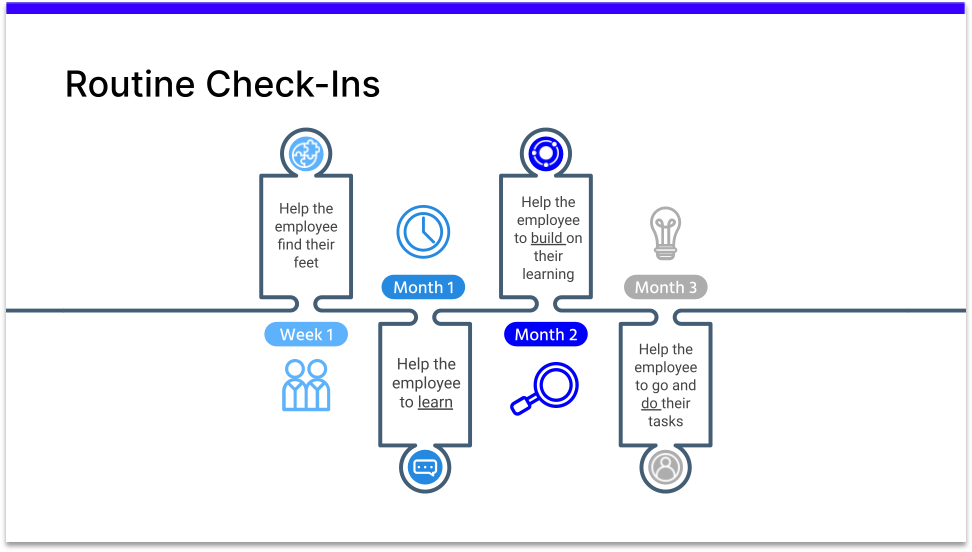
Consider implementing the 30/60/90 day approach to onboarding. This model has been proven to be highly effective for establishing productive and engaged employees. Essentially, by setting 3 key touchpoints with a manager the employee can more easily map out their onboarding experience. At the end of the first, second, and third month, there should be a one-on-one meeting between the employee and their mentor or hiring manager.
With a consistent pattern of meetings, the employee onboarding process is streamlined. All that is required from the manager is to review the onboarding checklist for the month and confirm if the employee has completed all of the specifications.
Closer guidance through these initial 90 days will facilitate the employee to develop into a full employee efficiently. An effective onboarding program is characterized by the efficiency of helping an employee to fully understand the company’s mission and culture. Check-ins provide a unique and secure moment for new hires to work all of this out with their hiring manager or mentor.
Download the Onboarding Check-In Template in Google Sheets and Excel here.
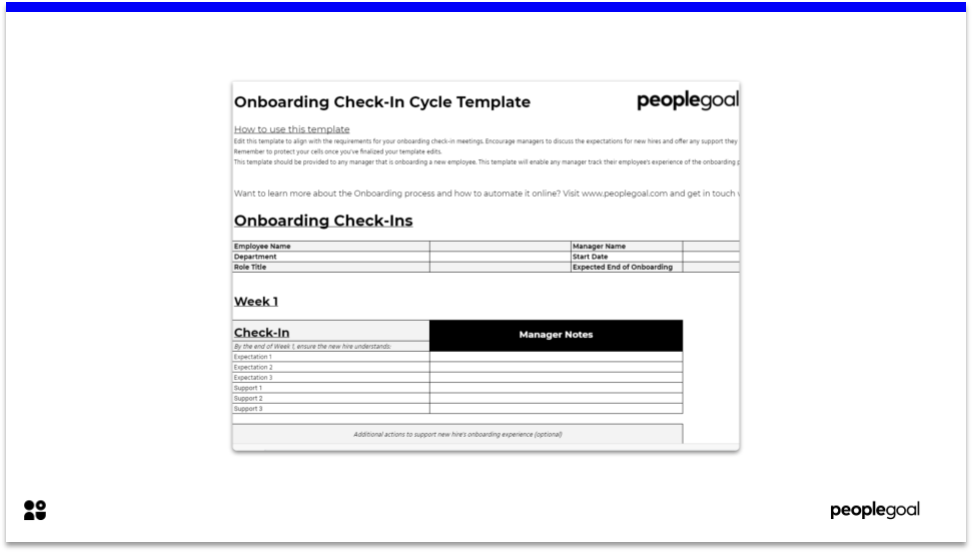
6. Onboarding Feedback
Linking back to the routine check-ins, another benefit of this step is the possibility to discuss the onboarding experience so far. At these milestones check-ins, the employee can give feedback on anything they need to. Whether they have an personal issue or if they want to shed light on their onboarding experience so far, the feedback given will present a fresh perspective of the company’s activity.
It is important to gather feedback from the employees themselves as this will give the most veritable reflection of the efficacy of the onboarding process.

In order to keep improving the onboarding process, it is necessary to gather insights from onboarding employees. Building on what you learn from their onboarding experience, you can avoid making the same mistakes or bring more focus to relevant areas.
The best way to understand the onboarding process is to ask those who have actually been through it. Whatever you gather from the feedback can be applied to improve the experience for the next wave of employee onboarding. This also has endless benefits in terms of sustaining better employee engagement.
Download the Onboarding Feedback Request Template in Google Sheets and Excel here.

7. Facilitating Remote Onboarding
As evermore companies have resorted to remote working, the onboarding experience presents very different hurdles for new remote employees to overcome. Proper preparation and handling of this new onboarding process will have significant benefits for your organization, particularly with maintaining a high level of employee retention.
Loneliness is one of the great challenges of the remote workplace. In 2019, Gallup found that a minority of remote workers (21%) experienced loneliness. However, since the pandemic, work from home has become non-voluntary for many, and social interactions outside of work are greatly reduced.

Remote new hires are in an unenviable situation. They have usually never met their co-workers in person. They are anxious to make a good first impression but may find it difficult to express their personality over Zoom. The usual icebreakers of the office environment just aren’t available anymore.
Luckily, HR professionals have worked in inventive ways to build community within the remote work environment. HR and managers must be intentional about creating opportunities for team building – especially for new employees.
In the busy remote workplace, it’s easy for new arrivals to go under the radar. Make sure everyone knows when there is a new employee – an announcement on a Slack channel that everyone can see works well.
Create a profile for new hires on internal social media. Ask them for a photograph and a short bio that outlines their interests and hobbies. This means that even in a large organization, new hires become familiar faces for everyone.
Schedule an icebreaker meeting during the training week, where new hires can introduce themselves. You might organize a virtual group lunch, where employees are given vouchers to order tasty food together.
There is a quicker time-to-productivity when new hires start work in supportive communities. Building team relationships from the first week creates an environment for collaboration and group learning.
8. Distribute the Employee Handbook
On arrival in a new company, it can often be unclear how an individual should go about their daily practices. Creating an employee handbook with useful tips to inform the new hire of where to find resources and how to get the most from their work are a great idea to help in the initial phases of onboarding.
Within this employee handbook, you may also want to write in the details of conditions of employment and useful information about your company. Providing your employee with a channel to better understand the company will encourage them to get learn more. Making it easier to access this information will inevitably help them to better appreciate the company’s mission.
An employee handbook should contain all of the information that an employee needs to know. In the first 90 days, this handbook should be a useful resource to assist the new hire for learning about the company-wide policies and more than the onboarding process, including advice on communication with team members, when to share personal information and a whole host more.
Download the Employee Handbook Template in Google Docs here.
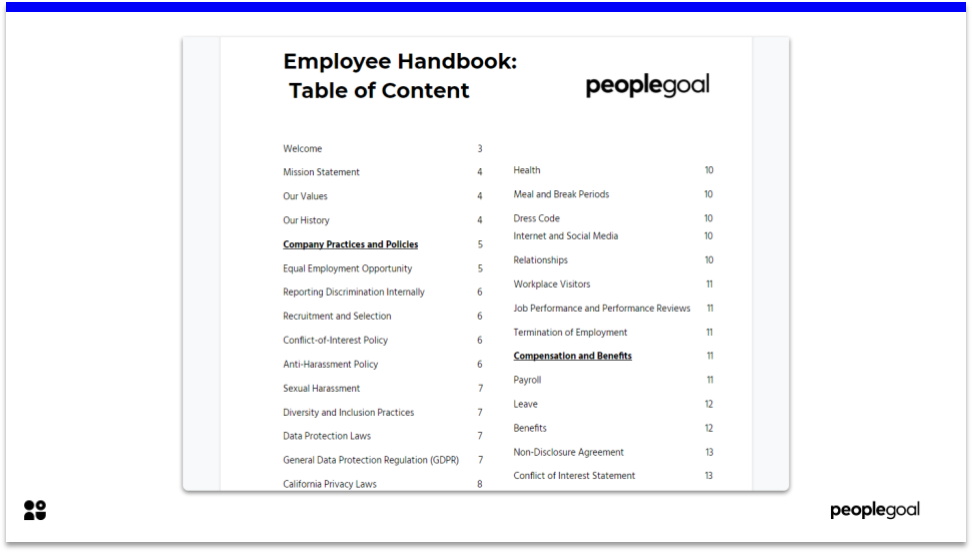
For further advice and information on creating your Employee Handbook, take a look at our guide here.
9. Promote Personal Development
Start as you mean to go on with the development of new employees and encourage them to become more involved with their learning and development plan from day one. This sets a tone for the understanding of work within your company – as a process of self and organization-wide improvement.
Emphasize the significance of career development by promoting the beneficial outcomes, not just for themselves, but also for the organization. The purpose of good remote employee onboarding is not just to enable a smooth transition into an organization but also to encourage employees to excel in their roles and grow their professional skills.
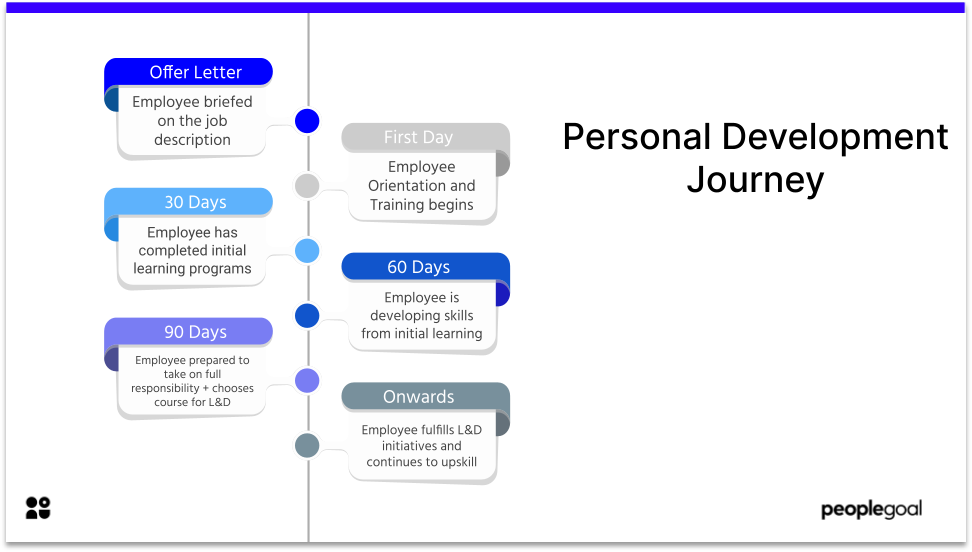
Build a career path
Humans are maximizing machines built to always strive for the next challenge. If you want to retain your best talent and grow your organization you need to provide your employees with space for development and a clear career path. Otherwise, they will go and look for it somewhere else.
We can all benefit from being stretched by development plans that encourage us to make our aspirations actionable. Many employees go to work, complete the same tasks every day and head home without feeling challenged. According to Gallup, only 35% of the workforce are engaged – this is unsurprising when we consider how many of us lack learning or training opportunities.
Development plans provide a possible cure. HR leaders and managers can draft plans that bring stretch and challenge into employee’s work lives. However, when you’re working with someone who’s really struggling, or with unengaged employees, it can be difficult to know where to start. As a result, establishing a routine of learning from the employee’s first day will facilitate an effective onboarding program and beyond.
10. Onboard in Cohorts (if applicable)
Why go through the same onboarding process five times a year when you could simply run through the whole onboarding program in one fell swoop? On top of saving time and effort, establishing a new team also encourages new employees to form bonds with the rest of the distributed team. This technique will also improve employee retention as it is less likely that a new employee will feel isolated in the onboarding process.
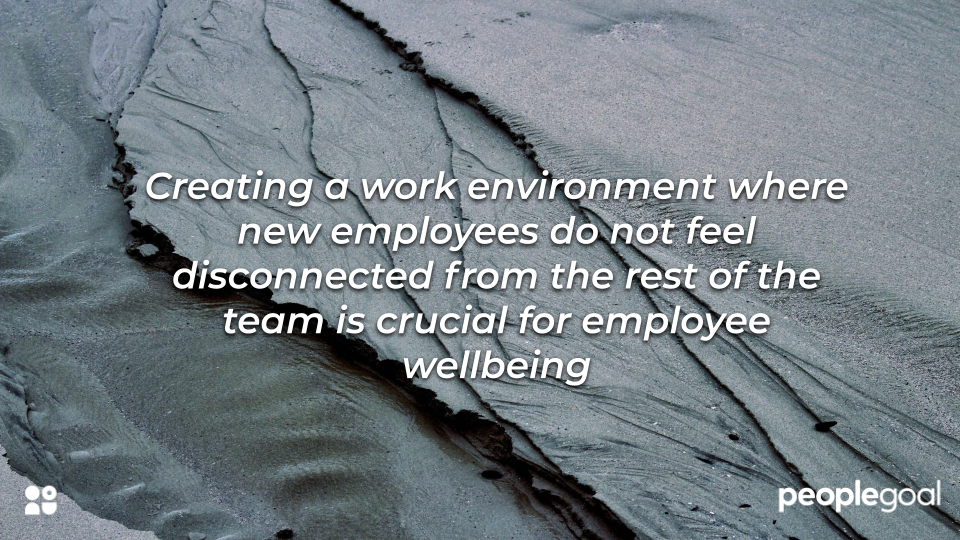
Furthermore, the employees will be able to communicate with these other team members through video calls or social media to learn and grow their confidence in the role. Creating a work environment where new employees do not feel disconnected from the rest of the team is crucial for employee wellbeing. An employee’s first day will be much more reassuring when shared with others in the same position.
From the moment that an employee receives their offer letter, HR teams should have a well-established routine for the onboarding process. Ensuring that the employee onboarding process is maintained and properly endorsed will facilitate new hires to attain a full appreciation of the company’s mission and culture.
Provided that you follow the steps above, you will be able to ensure high levels of employee engagement through a more productive onboarding experience. Doing the most to help each and every new employee as they are getting to know your company will significantly improve your own company-wide performance and reduce the risk of employee turnover. A few months of effective onboarding can inspire many years of top performance.
Ready to 3x Your Teams' Performance?
Use the best performance management software to align goals, track progress, and boost employee engagement.


